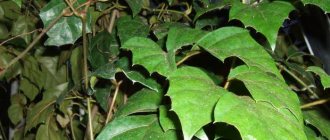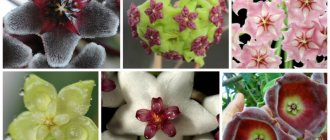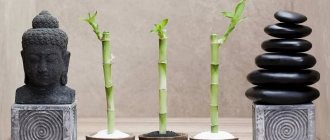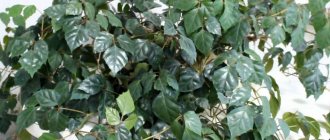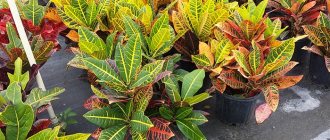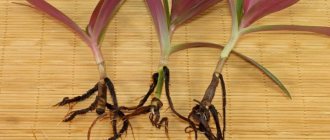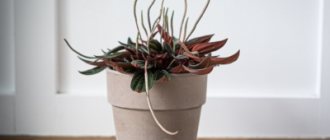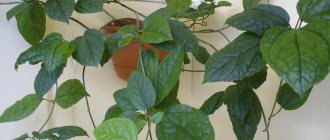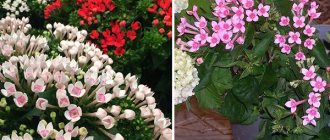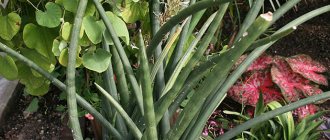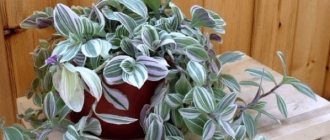The favorite flower of many gardeners is the birch houseplant. Its other name is rhombic rhombicus. This domestic vine is interesting because its leaves are very similar to the leaves of a real birch.
Because of this, they began to call her birch tree. From the article you will learn what kind of plant this is, what it is called correctly, what types of this plant are grown at home, and how to care for it.
Roicissus is very popular. It can be found in a variety of places: hospitals, offices, shops and even kindergartens. Many people keep it at home as it doesn't require much care and its rich greenery makes a great addition to home decor. People call it homemade grapes and bereka.
Houseplant birch: description
Birch, or rhoicissus, is closely related to the cissus family, which includes more than 300 species of shrubs, vines and subshrubs. This name comes from the Greek kissos, which means ivy. Roicissus, like cissus, is not an ivy; this name was given due to their external similarity. This plant is native to tropical forests.
The content of the article
- Houseplant birch: description
- Caring for a plant at home
- Reproduction of Rocius
- What diseases can indoor birch have?
- Folk signs about health benefits and harms
- How to make a phytowall from a birch tree
What does roisissus look like? This plant looks like a vine, see photo, the stems of which can grow up to two meters, the leaves are green all year round. In apartment conditions, cissus rarely blooms, but its flowers can hardly be called beautiful, since they are rather inconspicuous. But the birch leaves grow gorgeous - diamond-shaped, a little like the leaves of a real forest birch. This “living” climbing decoration comes from the grape family, and it is very easy to grow it yourself.
How many types of birch are there?
Rhombic rhoicissus - is a long stem (up to 1.5-2 m) with thin shoots and bright green leaves. The outer side of the leaves can be emerald, the underside - lighter tones. All stems, like the leaves, have a small “edge” of a reddish color. In addition, small tendrils can be found on the stems. Roissus of this species is suitable for growing in special flowerpots; it is used to decorate columns or phytowalls.
Cape roisissus is a climbing plant that can be grown on supports. Its stems reach a length of 2 meters. Characterized by rapid growth. It has beautiful decorative leaves that look like grapes. Most often used for volumetric phytocompositions.
Palmate roisissus is very different from its counterparts. It was named so because of the shape of its leaves, which look like fingers. This type is actively used for decorating rooms and phytofigurines. The leaves are painted in a bright emerald color, covered on the inside with fine reddish hair.
Felt roisissus has the simplest leaf shape of all, that is, round. The edge of the leaf is wavy, the leaves themselves are dark green in color. The outer side of the leaf is glossy and shiny, the underside has a small edge of reddish pile. When flowering, inflorescences of small cream flowers appear.
The three-toothed rhoicissus has a complex leaf structure; the plate is divided into 3 parts. The leaf edge is coarsely toothed. The upper side is painted dark green, the lower part of the leaf is in lighter colors. The flowers are yellow, with a barely noticeable green tint.
Types of indoor cissus
There are more than 300 species in nature, but much fewer are domesticated. This:
- quadrangular (cactus-shaped) - the shoots are thick, about 1 cm in diameter, tetrahedral (hence the name). The leaves consist of three parts, are small, and fall quickly. The species is photophilous and grows quite slowly.
- bicolor (multi-colored) - a climbing shrub with ellipsoid leaf blades covered with silver spots with a purple tint. The flowers are yellow, collected in umbrellas.
- Antarctic - the leaves have the shape of an elongated heart, herbaceous - green. The flowers look like little green umbrellas.
- rhombifolia - a fast-growing vine that requires support, the shoots are thin, the leaf blades are complex, consisting of three diamond-shaped parts. The entire plant is covered with reddish hair, which increases its decorative value.
Caring for a plant at home
Homemade grapes or birch trees have long been living in the houses and apartments of lovers of ornamental plants. The plant is characterized by fast growth, unpretentiousness and the ability to create excellent living decor.
A few tips for caring for birch trees
This plant does not like exposure to direct sunlight. They can burn the leaves. If a birch tree is disturbed by bright light, this can be seen in its condition: the leaves will lighten several tones, they will lose their glossy shine, and they will begin to fade. In this case, you need to move the container with the flower to a more shaded place.
- A birch tree will grow better if its soil is loosened frequently. This should be done at least once a week.
- The flower does not like excess moisture, but despite this, the leaves need to be sprayed sometimes. Especially in winter, when greenery can suffer from dry air.
- There should be no drafts in the room where the birch tree lives. It is also not recommended to ventilate it on the balcony. The plant may get sick after such walks.
- To rejuvenate the vine, once a month you should carefully trim all old shoots and trim any that are too long. Then the flower will have a well-groomed appearance.
How to choose soil and replant
Before purchasing a birch tree in a store, you need to carefully inspect it. The leaves of the plant should not look drooping, in addition, the cuttings should have two buds.
The plant must be replanted every 3-4 years. You can make the soil yourself: to do this, you need to take 2 parts of soil from the garden, 2 parts with turf, 1 part of humus and add 1 part of coarse river sand. The resulting mixture will perfectly allow moisture to pass through and nourish the roots of the plant. If it is not possible to prepare the soil yourself, you can purchase it in special stores.
Roicissus can be transplanted into a flowerpot, hanging basket or shallow tub. If the owners have chosen a pot for him, then it should be small. This plant will not be comfortable living in a large space. The container must be made of natural material. There must be holes at the bottom for moisture drainage.
A layer of pebbles or expanded clay should be placed at the bottom of the pot. When the drainage is ready, you need to pour 3-4 cm of soil on top. Before planting a birch tree, you must carefully examine its roots and carefully remove all broken and dried ones.
Then the flower should be placed in the middle of the pot and sprinkled with soil. There is no need to compact it too much; you can only lightly press the soil with your fingers. There should be no empty spaces left near the roots. The roots of the birch tree should not be deeper than 5 cm. After the transplant is completed, the plant needs to be watered with settled water at room temperature.
The first days after transplantation, it is better to protect the flower from sunlight. It is best to hide it in a dark closet. If it takes root well, then it can be moved to a permanent place of residence. For the first 2-3 months, the flower does not need to be fed; it will take everything it needs from the soil.
How to choose lighting
Birch trees can tolerate both sun and shade well. But he still loves the shadow more. Direct sunlight can damage the delicate leaves of this plant, so it is better to keep it on a windowsill in the northern part of the apartment.
Owners should not forget that the vine is a tropical and delicate plant, and it does not tolerate life on a loggia or balcony. In the summer, it should also be in the apartment. Birch does not tolerate drafts and open spaces.
In summer, the air temperature should reach 20-25 degrees. This is the most favorable climate for homemade grapes. In winter, the temperature should be at least 16 degrees. When ventilating the room, do not allow cold air to enter the plant.
How to water a birch tree correctly
The plant, although tropical, is quite unpretentious. It can survive unfavorable conditions, but it is unlikely to survive a lack of water. When watering, you must follow one important rule: the plant does not like excess moisture, but there should not be dry soil in the pot either.
On average, 2-3 waterings per week are obtained. It depends on where exactly the pot with the vine is located. If closer to the ceiling, then the air there is hottest and driest, and the flower needs to be watered more often. If the roisissus lives on an ordinary windowsill, then 1-2 waterings will be enough for it. Several times a week you need to spray the leaves of the plant with a spray bottle.
The water in the pot should not be allowed to stagnate, as this can lead to root rot. Therefore, there must be drainage and special holes in the bottom of the container. If water is poorly absorbed by the soil, then you should add a loose substrate to it; it can be purchased at the store. Compaction of the soil can occur because the plant lives in one container for a long time; in this case, replanting will solve the problem.
Many gardeners, especially beginners, water their home plants with tap water; such watering is harmful to the plants. Water contains impurities that can accumulate in the soil and have a negative effect on the flower for a long time. Water for irrigation must be settled or filtered. You can also use melt water.
In winter, you can notice that the leaves of the birch tree begin to dry out even with sufficient watering. This is how the plant reacts to dry air. The solution to this problem is simple: place a small cup of water next to it or spray the leaves with a spray bottle.
How to feed a birch tree
Sometimes gardeners do not pay due attention to fertilizing, guided by the fact that the plant is not capricious and does not require anything other than normal watering. Fertilizers should be used to ensure that the birch tree looks good and its greenery constantly grows.
Feeding is carried out a couple of times a month. Liquid fertilizers can be purchased at any gardening store. It is best to start feeding in the middle or end of March, and finish at the end of October. In winter the flower rests.
Cissus: reproduction and care
The flower propagates very easily. It is enough to cut the top cuttings and root them in water or soil, having previously treated the cuts with a growth stimulator. As soon as the plant gives roots, it is transplanted into a pot.
Caring for cissus is quite simple. The plant will grow magnificently if you follow simple rules:
- All plants are light-loving, except for the rhomboid species, which loves shade. It is recommended to place them on a south, east or west window, but do not allow direct sunlight;
- The optimal growth temperature is +20-+25 degrees. Birch prefers moist air, so in dry weather it should be sprayed;
- the plant loves moisture, which quickly evaporates due to lush foliage. In hot weather, abundant watering is necessary;
- Feed the flower every week with compounds for indoor plants.
Reproduction of Rocius
Birch trees have two methods of reproduction:
- Using cuttings. It is best to do this in spring, when new branches appear on the vine. The cuttings should be carefully trimmed so that at least two internodes remain. All cut cuttings should be placed in a container with a damp mixture of sand and peat. After 12-14 days, the plants will be ready to be transplanted into a normal container.
- With the help of shoots. After winter rest, the plant must be cleared of old shoots and slightly rejuvenated. Cut branches can be placed in water until roots appear, and then transplanted into pots with suitable soil.
Additional care. In order for the birch tree to be more magnificent, it is necessary to pinch the tops of the stems. Birch lashes need support, then they develop much faster.
Possible pests and their control
House plants, even the most unpretentious ones, also suffer from attacks by pests, among which are:
- Leaf aphid. Many house plants suffer from these small insects. Getting rid of them is very simple: you need to make a strong solution of laundry soap and spray the flower with it. It is easy to detect aphids; you just need to carefully examine the underside of the leaves.
- Spider mites appear on grassy vines when watering is improper, when the plant lacks moisture. The main sign of the presence of mites is the appearance of small cobwebs on leaves and shoots. You need to fight ticks using a special product sold in stores. In addition, the plant needs to be returned to proper watering.
- Scale insects are a rather dangerous pest for indoor plants. It usually lives on stems and leaves, and is sometimes found on stems. The insects have an oval shape and a flat body, the lower part fits tightly to the plant. There are two types of scale insects: false and true. Real ones know how to hide under their shells, like turtles, but false scale insects do not have this ability. The reproduction rate of scale insects is high, so colonies appear very quickly. They suck the juice from house plants, causing them great harm. If you don’t start fighting them in time, the vine will die. Means for exterminating scale insects can be purchased at gardening stores.
- The fool is white. This insect lives in soil, especially in soil that contains a lot of humus. It has an elongated body on which small antennae are visible. It feeds on plant remains, but does not disdain living roots. Because of this, the plant can become sick and wither, and eventually die.
- Mealybugs. These small worms are white in color and like to settle on the back of leaves, closer to the passing vein. Female scale insects are larger, their size reaches 0.5 cm. They make homes for their numerous offspring; the houses look like cotton balls. Females store eggs in them. Usually these insects do not live on vines, preferring cacti and azaleas to them, but if a birch tree is adjacent to these flowers, they can settle on it.
Insect pests and diseases
Today there are plenty of diseases and pests that affect indoor plants.
Birch, unfortunately, is no exception. Its most important enemies are insect pests. First of all, these are spider mites and scale insects. The reason for their appearance may be poor watering and low air humidity. The fact that a spider mite has appeared can be indicated by cobwebs on the stems and leaves. Small growths that hold tightly to the surface of the stems or leaves indicate that the flower is affected by scale insects. First of all, these pests attack the leaves of the flower.
What diseases can indoor birch have?
What to do if the plant is sick. Carefully inspect the vine if:
- Leaves lose their color. The reason for this may be a lack of nutrients in the soil. It is necessary to change the fertilizer or increase its amount.
- The foliage becomes wrinkled and covered with dark spots. The reason is insufficient watering and dry air. For the same reason, sheet plates can become deformed, bend inward or outward.
- The leaves began to dry out and the shoots began to shrink, which means there is too much watering or the air in the room is very humid.
- If the plant leaves abundantly, then root rot or sharp fluctuations in temperature in the room are to blame.
- In the cold season, the flower grows slowly, and this is completely normal. If he doesn’t grow well in the summer, it means he doesn’t have enough nutrition from the soil and should be fed.
Possible problems in growing birch trees
Why does the plant begin to wither and dry out? The reason is improper care and maintenance. The plant must be constantly inspected for the presence of pests. Problems that gardeners may encounter:
- The leaf blade becomes deformed and dries out. The reason is dry air in the house; to correct the problem, just humidify the air around the flower.
- The leaves turn pale and fall off. This is due to high temperature. Place the pot with the birch tree in a cool room. In summer, the flower can be taken out into the fresh air.
- Brown leaves appear due to too humid air and constantly wet soil. Do not water the flower until the soil has dried two centimeters.
- Abundant shedding of foliage is the result of the flower being in a draft and in a cold room. The situation can be corrected by normalizing the temperature.
- Leaves fade due to lack of minerals. Adding nitrogen will return the birch leaves to their original color.
- Stunted growth is associated with a cramped pot. Transplanting the rhoicissus into a larger pot will provoke the appearance of new branches.
If the maintenance is poor, the flower may get sick and be spoiled:
- Gray rot. Gray mold forms on the leaves, then the leaf begins to rot. This happens due to waterlogging of the soil. Diseases can be controlled using fungicides.
- Spotting. It is manifested by the formation of dead areas on the leaves. Unlike fungal spots, bacterial spots have clear contours. Three sprays are carried out with a 1% solution of Bordeaux mixture.
- Spider mite. The plant is covered with a thin web. White-yellow blotches are visible on the leaf. To destroy the pest, the leaves are washed with soapy water, and then the preparations Actellik and Fitoverm are used.
- Greenhouse aphid. The insect is dangerous because it sucks the juice from the plant. The leaves turn orange, then curl and fall off. The drugs Actellik and Fufanon are used against aphids.
Important! Birch is a wonderful indoor plant, which is used as decoration and decoration of the room. It does not require special care, so it easily takes root in offices, educational institutions, and technical rooms.
Folk signs about health benefits and harms
There are many folk signs and beliefs associated with the birch plant. Many people, having heard enough, begin to doubt whether it is possible to keep it at home.
Some are sure that roisissus is a muzhegon, that is, a man can leave the house where it grows. All these signs are far-fetched, since birch trees can be found in those houses where spouses have been living together for many years and the husband has no plans to leave. So, the vine will not cause anything bad to people and you can safely keep it at home.
Recently, birch has become very popular, as a new interpretation has appeared that it improves immunity, inspires a person to new ideas and normalizes the atmosphere in the house.
This news was confirmed by scientists. Studies have shown that birch not only decorates the room, but also improves air quality, it becomes cleaner and more humid. It can also absorb harmful substances from the air.
Birch leaves turn yellow and dry - what to do?
A very common problem that gardeners face is that birch tree leaves dry out and turn yellow:
- If the leaves of a birch tree dry at the tips, this indicates that the air is too dry for the plant.
- Over-wetting the soil can cause mold and brown spots to appear on the foliage.
- If the leaves lose their natural color and the flower rapidly stretches upward, it means it lacks nutrients. This flower needs to be fed.
- A sharp change in temperature and rotting of the root system can cause massive leaf loss on a birch tree.
- If cissus grows slowly in winter, then this is a natural process. If this happens in the summer, it means the flower is suffering from a lack of nutrition.
Give your pet the proper care and attention, and your indoor flower will grow healthy and beautiful.
How to make a phytowall from a birch tree
Landscaping an apartment or house is not only a beautiful design, but also an excellent air filter that can be installed in any room: office, home office, children's room or living room.
Making a phytowall yourself is not at all difficult. To do this, you need to purchase a phytoblock (phytomodule). The structure does not need to be connected to water supply or electricity, so it can be placed in any convenient place in the apartment.
The phytoblock must have several parts:
- Sturdy wide frame. It is necessary to ensure that the plant does not adhere to the wall, which can cause mold due to poor air circulation.
- A layer of polyethylene or other material that does not allow moisture to pass through.
- Fabric with small pockets. The fabric for the canvas should be very durable; it is best to purchase synthetic felt. It does not deteriorate so quickly from exposure to moisture.
- A tray is required to collect water from below.
How to assemble a phytoblock correctly
You need to sew a rectangular fabric. One edge needs to be folded and stitched in several places to create pockets. Their size and depth depend entirely on the taste of the owners. For sewing, you need to take nylon threads - they are the strongest.
The finished canvas should be glued to a plastic board. Plastic will serve as additional protection against moisture.
You need to secure the frame at the selected location. To do this, you can use a block coated with a layer of special antiseptic. The block can be replaced with an aluminum profile. In order for there to be normal air circulation between the wall and the structure, a small gap should be left - approximately 2-3 cm.
A tray must be attached to the bottom of the structure to prevent moisture from dripping onto the floor after watering.
How to green a phytostructure
In order to green the finished structure, you should carefully remove the rhizissus from the containers. You need to clean off excess soil from the roots, then carefully wrap them in a damp cloth. Prepared plants are placed in pockets on the canvas. After some time, the flowers will grow their roots into the fabric, so they cannot be touched.
The indoor birch plant is a decorative flower that is suitable for any room. It does not require much attention, but brings great benefits to a person, moisturizing and purifying the air from harmful impurities.
- Read: How to grow asparagus at home
Be healthy, dear readers!
Birch tree transplant
Indoor birch flowers do not often require replanting, but after 3 years the procedure will have to be carried out due to depletion of the soil and a decrease in the space of the flowerpot for the root system.
Transplanting an indoor birch tree
Algorithm for the procedure:
- Prepare a substrate and a pot 2-3 cm larger in diameter than the previous one.
- Place a drainage layer at the bottom of the container, which will be 1-2 cm.
- Then a several centimeter layer of soil is laid.
- Inspect the shoots of the root system. Trim damaged parts. Treat the sections with crushed activated carbon powder.
- Place the sprout in the center of the container.
- Place the roots evenly around the perimeter of the pot.
- Cover the roots with soil without compacting them. The height of the layer should not be more than 3 cm.
Note ! Transplantation can be carried out only in the spring - at the moment of emergence from dormancy. It is not advisable to carry out such a procedure during a period of active growth.
Moisten the soil by spraying the substrate with water from a spray bottle. Place the transplanted specimen in the shade for 5-6 days. During this time, the root system will become stronger and the above-ground part will begin to grow.
